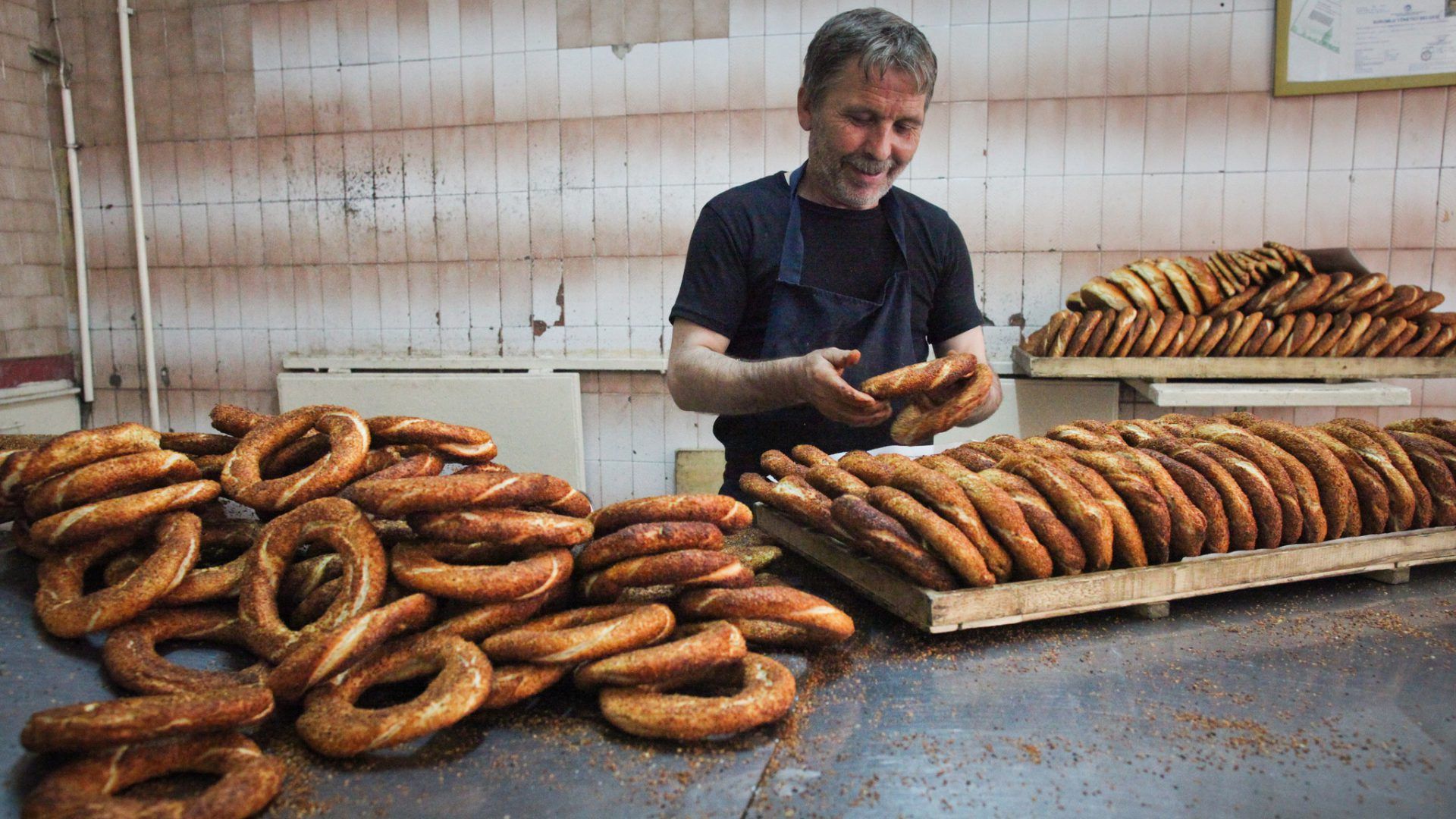It is probably the most famous Turkish street food. For just one Turkish Lira you can hold centuries of Turkish cuisine in your hand. At first sight it might seem like a bagel to you, but simit is more than just a bagel. Simit comes along with a wider outside diameter, so its way bigger than a bagel but also more somehow more elegant. Outside they are really crispy and side soft and fluffy. The variety of different simit types is distinctive. Each region and even city tends to have its own version.
The İzmir version of simit is called “gevrek” (crispy), but it’s very similar to the ones from Istanbul. In Ankara you will find smaller, darker and crispier ones. On selected days you can buy “kandil simidi”, which are smaller and harder, more salty and have a cinnamon taste. Religious holidays are called “kandil”. People buy and give away kandil simidi as a treat to relatives. And then there are the “susamsız simit”, simits without sesame seeds, which reminds inevitable more to a naked cat than to a simit.

The ring-shaped yeast dough covered with sesame seeds are a well supplement for a cup of cay. Simit is generally served plain, so it’s the perfect snack to go. Moreover it is used for breakfast served in a sweet version with honey, kaymak and jam or it comes with salty side dishes like cheese, tomato, cucumber and olives. In Turkey, especially in Istanbul, you can find thousands of simitçi selling their goods at the street. These street vendors either have a simit trolley on a certain fixed location or they carry the simit in a tray on their head around the lively alleys. They jell out “simitçi”- simit seller, “taze simit”- fresh simit or “fırından yeni çıktı”- new ones right out of the oven. On the street you can buy it together with a triangle shaped package of cream cheese, which is called “üçgen peynir”. You dip the simit into the cream cheese, so there is no need for cutlery.
To don’t depend on them anymore, just learn how to make this delicious circular bread at home.
Recipe for 13 Simits:
For the dough
- 1 kg all-purpose flour
- 550 ml lukewarm water
- 100 g vegetable oil
- 2 packages active dry yeast
- 2 teaspoon salt
- 1 teaspoon sugar
For the curst
- 200 g sesame seeds
- 150 ml pekmez (grape molasses)
- 150 ml water

Take a big mixing bowl and pour the lukewarm water in. Stir the yeast and the sugar into the water. Put flour, salt and vegetable oil to the liquid. Mix everything for about five minutes by hand or with the help of stand mixer with dough hook, until the dough comes together really smooth. Beware of the kneading by hand requires some muscle work. Let it rest in the bowl for about one hour covered with a damp towel at a warm place, but not warmer than room temperature.
While letting the dough rest, start to prepare the ingredients for marking the curst. Mix pekmez and water in a bowl and put it aside. Roast the sesame seeds on low to medium heat in a big pan. Stir or shake the pan regularly to prevent the sesame from burning. Be careful, after a certain point the sesame seeds are turning dark quite fast. Make sure all sesame seeds get evenly tanned. Put the roasted sesame seeds in a bowl and put it aside.

After one hour the dough should have doubled its size. Knead the dough on your kitchen countertop to get the air out; otherwise you will end up with unregularly air holes in your bake goods later. Take a section of about 130 g of dough, roll it to a long and thin string of about 50-70 cm. Lift the sting and twist it from the middle on into a two stranded rope. Wind the dough rope around your hand. Join the ends together to make a circle, pressing the ends firmly together with rolling hand movement on the kitchen countertop.
Get your prepared pekmez-water-mixture and the roasted sesame seeds. First bade the simit in the liquid, than coat it with sesame seeds from all sides. Put the coated simit on a backing paper covered backing tray. Four simits should fit on a regular backing tray easily. Let them rest for 10 minutes. Then put them in the pre heated oven for about 13 minutes at 250°C (482°F). To ensure a nice moist inside and a crispy outside of the simits, put a bowl oven proved dish with boiling hot water on the ground of the oven.

After 13 minutes of baking, check for the color of the simits. They should be light golden brown from outside, but not too dark. If necessary give them a few more minutes. Take them out, eat them right away or let them cool down completely.
And one fun fact for the end: in Turkish the word simit is also used for lifebelts and belly fat, because they are going around ones belly in a ring shape.
Afiyet, bal, şeker olsun!
